If you’re a fan of the Can Do Descriptors for WIDA framework users, get ready. I’ve got a wonderful new resource to introduce to you.
Teachers of English learners often ask:
- How do I know the extent to which I need to scaffold (i.e. provide support within) instruction that I provide?
- What kind of language should I expect my English learner to produce or understand?
- What exactly does it mean that they are at a “level 2?”
- How can I assess my student’s progress in English over time?
These are wonderful questions to ask! Every learner is so unique. Language development is a journey that looks different for each individual. So it’s important that we stay curious about how we can know and support them well.
Of course, most teachers aren’t language specialists. In fact, a very small number of teachers are trained specifically in supporting multilingual learners. Knowing this, the developers of the WIDA ELD Framework created a tool called the Can Do Descriptors. (Find it in the 2012 edition of the standards). For WIDA states, this tool has become widely used as a resource for getting a glimpse at skills across the language development process.
Introducing the Can Do Descriptors New “Cousin”
With the newest edition of the WIDA standards, released in 2020, a new tool has been introduced– the Proficiency Level Descriptors. I like to call this resource the “cousin” of the Can Do Descriptors. They have some similarities, and some differences. It’s important that we get to know the new Proficiency Level Descriptors, so that we can fully utilize the 2020 WIDA Standards Framework.
First, let’s touch briefly on how WIDA uses a leveling system to bring definition to the language learning process.
Note: This three-part blog series will supplement the training already available through WIDA. I encourage you to take part in the essential training offered by WIDA, and/or your state. References to WIDA framework components and images shown in this series are shared from and credited to WIDA’s website.
This is blog three in a three-part series introducing the WIDA 2020 ELD Standards as a resource for K-6 educators. Find the first blog here.
Understanding the WIDA Language Levels
In 2004, WIDA developed a leveling system to bring some definition to how we assess fluency in academic English. This system, as shown in WIDA’s Performance Definitions (expressive and receptive), described language “levels” 1-5.
The 2020 edition includes an expanded description of a sixth language proficiency level. These six WIDA language levels are set in a new context: The Proficiency Level Descriptors. This component provides “elaborated, developmental interpretations for multilingual learners’ proficiency levels in English.” (from WIDA 2020 ELD Standards Framework) We’ll look at the Proficiency Level Descriptors in a moment.
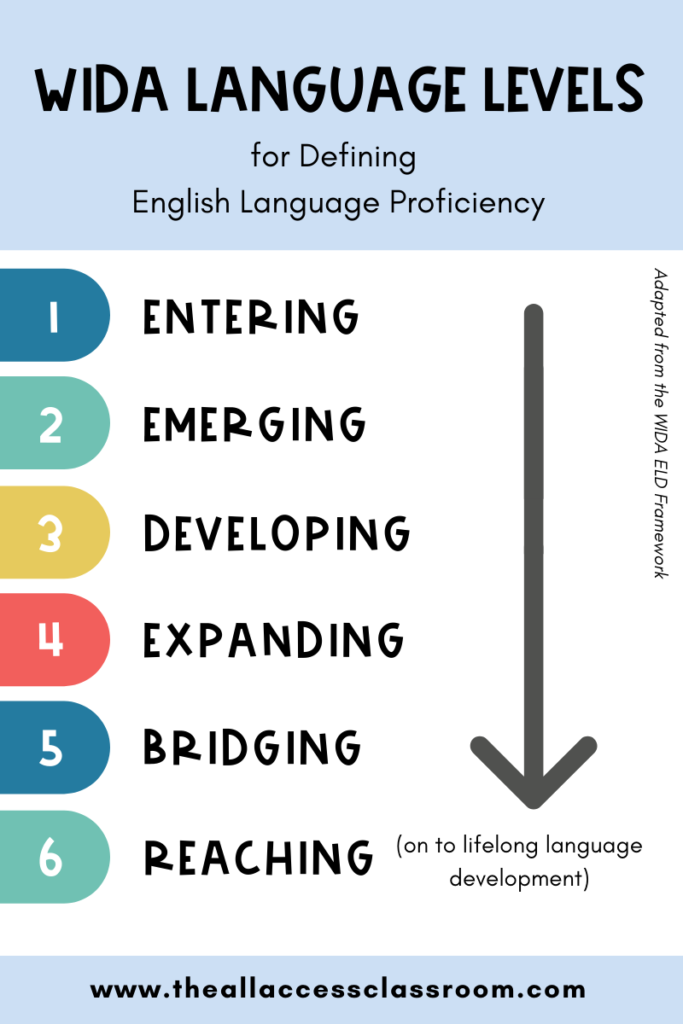
When ELs first begin learning English, they communicate using Level 1 (Entering) language skills. As they develop more linguistic tools for academic purposes, they progress through the continuum. The ultimate goal is for each individual to grow over time to Level 6 (Reaching). Here, they will continue as lifelong language learners.
Each WIDA state has developed its own criteria for both entering and exiting an ESL program. This is based on assessment data that refers to the six language levels. It typically includes the annual WIDA ACCESS scores.
What About the “Old” Can Do Descriptors for WIDA Framework Users?
Over the years, WIDA has produced many very helpful tools and resources for teachers of multilingual learners. The Performance Definitions and the Can Do Descriptors are two that are still available in WIDA’s resource library. They go hand-in-hand. Both indicate specific language skills that may be demonstrated at each proficiency level.
Although there are many similarities between the Performance Definitions/Can Do Descriptors and the new Proficiency Level Descriptors, there are two major differences:
- The new Proficiency Level Descriptors align specifically with the 2020 edition Language Expectations (language standards).
- The new Proficiency Level Descriptors are organized around grade-level clusters (rather than a far more broad K-12 application).
In my personal view, the 2020 edition’s Language Expectations provide the most relevant, useful tool for teachers that WIDA has yet produced. (Huge kudos to WIDA!) With the Proficiency Level Descriptors coordinating well, the two together really do meet most instructional needs. However, WIDA has not branded the older resources as obsolete. They still remain valid tools for reference, as needed.
To learn more about the specific differences between old and new resources, see the 2020 WIDA ELD Standards Framework, Appendix D.
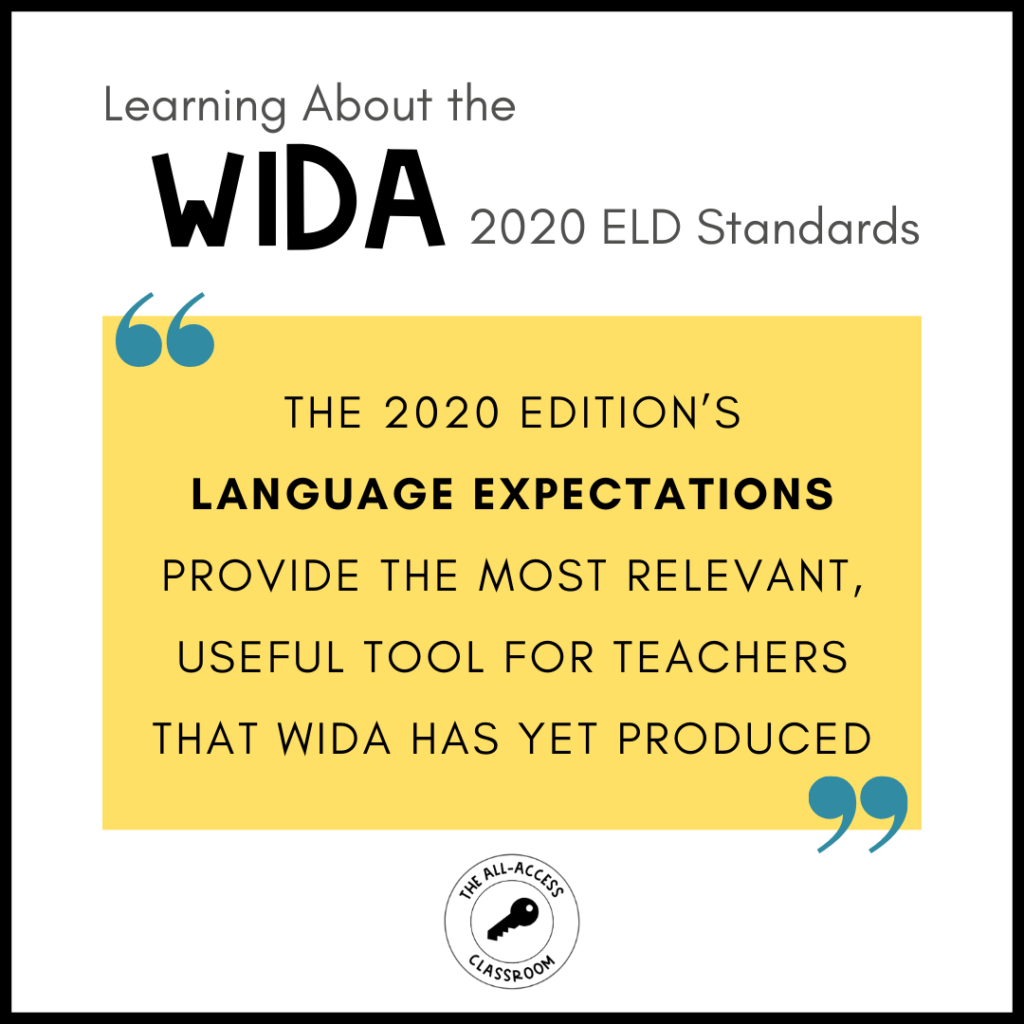
Introducing the WIDA Proficiency Level Descriptors
You can find WIDA Proficiency Level Descriptors (PLDs) within each grade level cluster section of the 2020 standards. The standards are free and can be downloaded via the WIDA resource library. Each set of PLDs is organized into two tables. One shows descriptors for the “interpretive communication mode” (listening, reading, and viewing). The other shows descriptors for the “expressive communication mode” (speaking, writing, and representing). These modes are what help the PLDs align well with the main Language Expectations. Nice and simple!
Each PLD table has a column for each of the six language proficiency levels. Then, you will find rows that represent the various “dimensions” of language. We all make decisions within these dimensions, as we communicate for various purposes. They are: Discourse, Sentence, Word/Phrase. One way to think about the three dimensions is as follows:
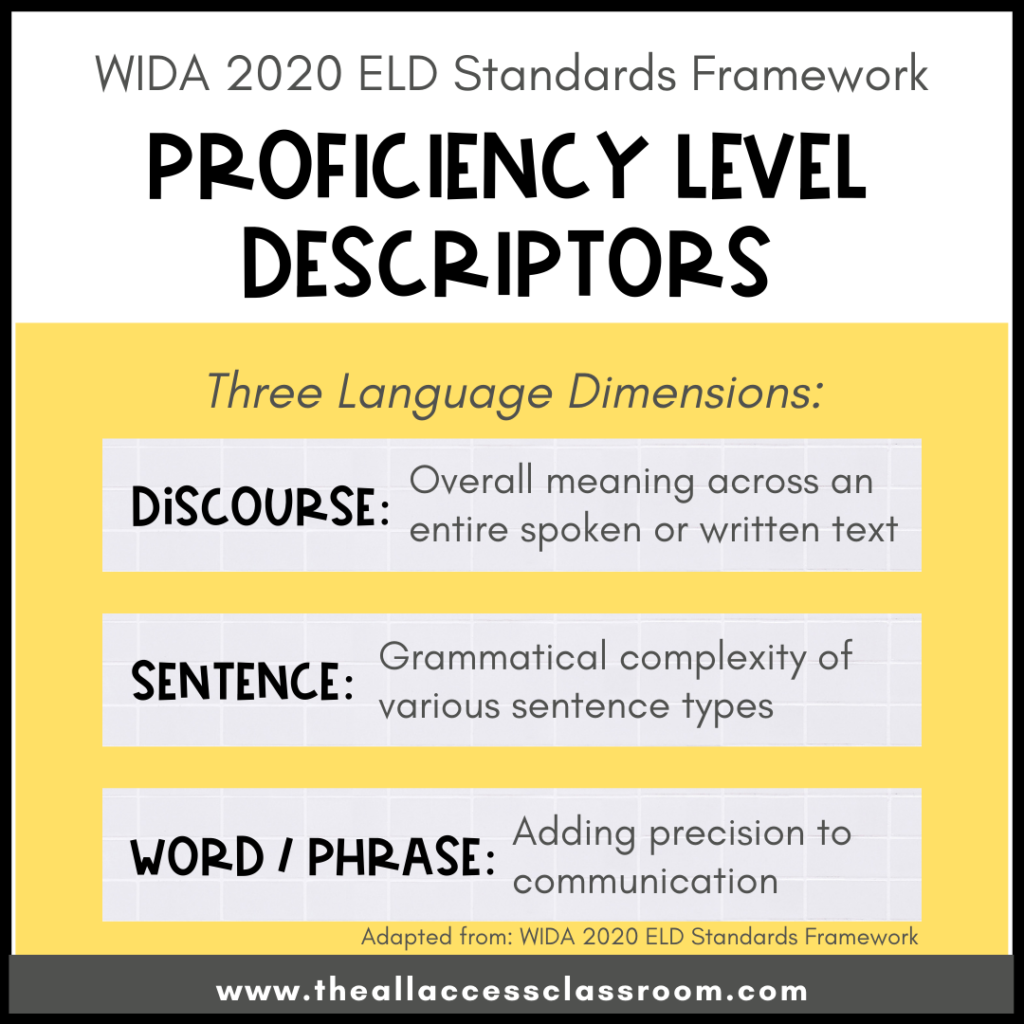
Finally, each “box” in the PLD tables defines how students will understand ideas (if interpretive communication) or create/connect/elaborate/extend ideas (if expressive communication). You might call this “the nitty-gritty” of how students employ specific grammar/usage at each of the WIDA language levels.
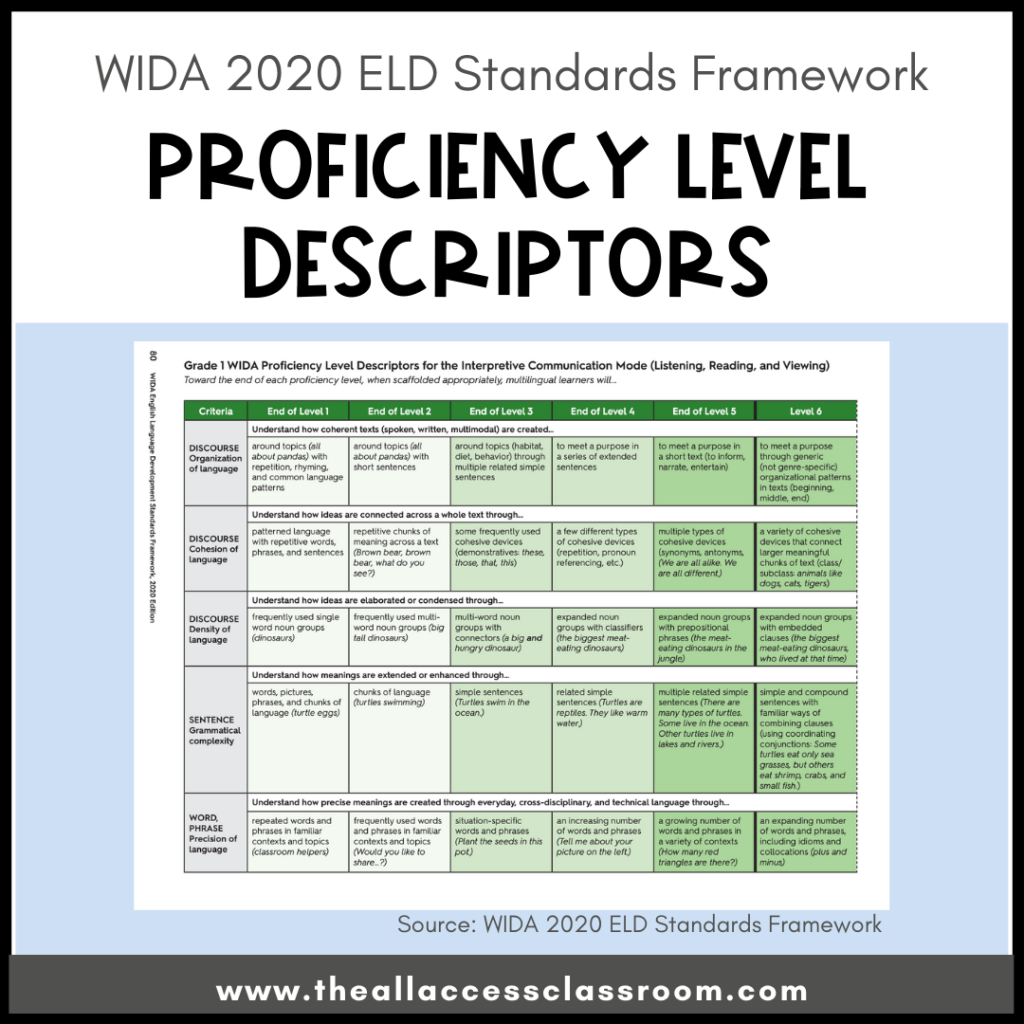
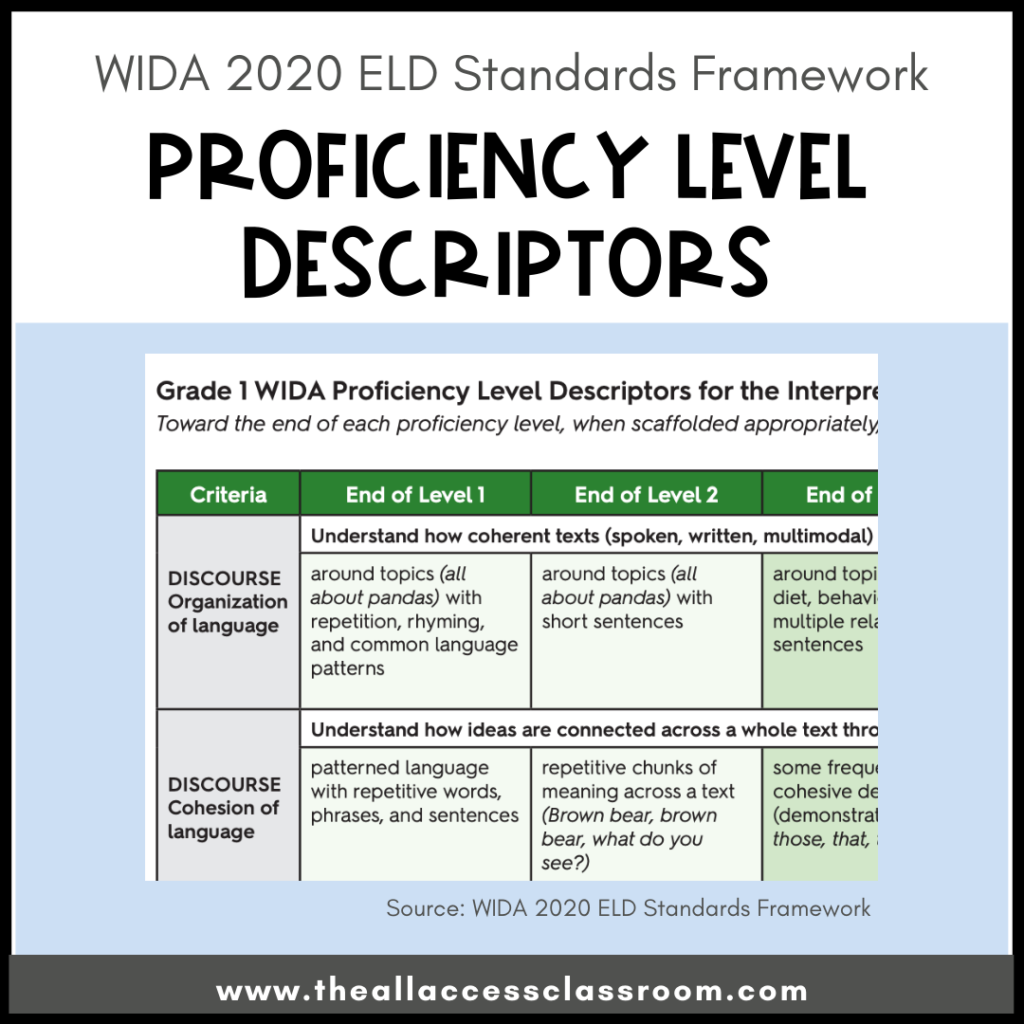
Some Points to Keep in Mind
- On each page of the PLDs, WIDA explains: “Toward the end of each proficiency level, when scaffolded appropriately, multilingual learners will…” (2020 WIDA ELD Standards Framework). It’s important to remember that our instructional goal is to scaffold grade-level content. so students can have equitable access and rigor. We don’t want to use the PLDs as a reason to limit students’ exposure to the same academic language and texts used by peers. We want to offer exposure AND scaffolded experiences which lead to growth and success.
- Language acquisition will be a unique journey for each learner. Students may not follow a linear, predictable progression of skills. They may demonstrate varied proficiency levels, depending on the activity.
- Rather than using the WIDA Language Levels as a kind of label for students (i.e. “She’s a Level 2…”), we might rather refer to her ability (i.e. “She’s at a Level 2 in expressive language…”).
- In the Proficiency Level Descriptors, “text” refers to both written text and spoken language.
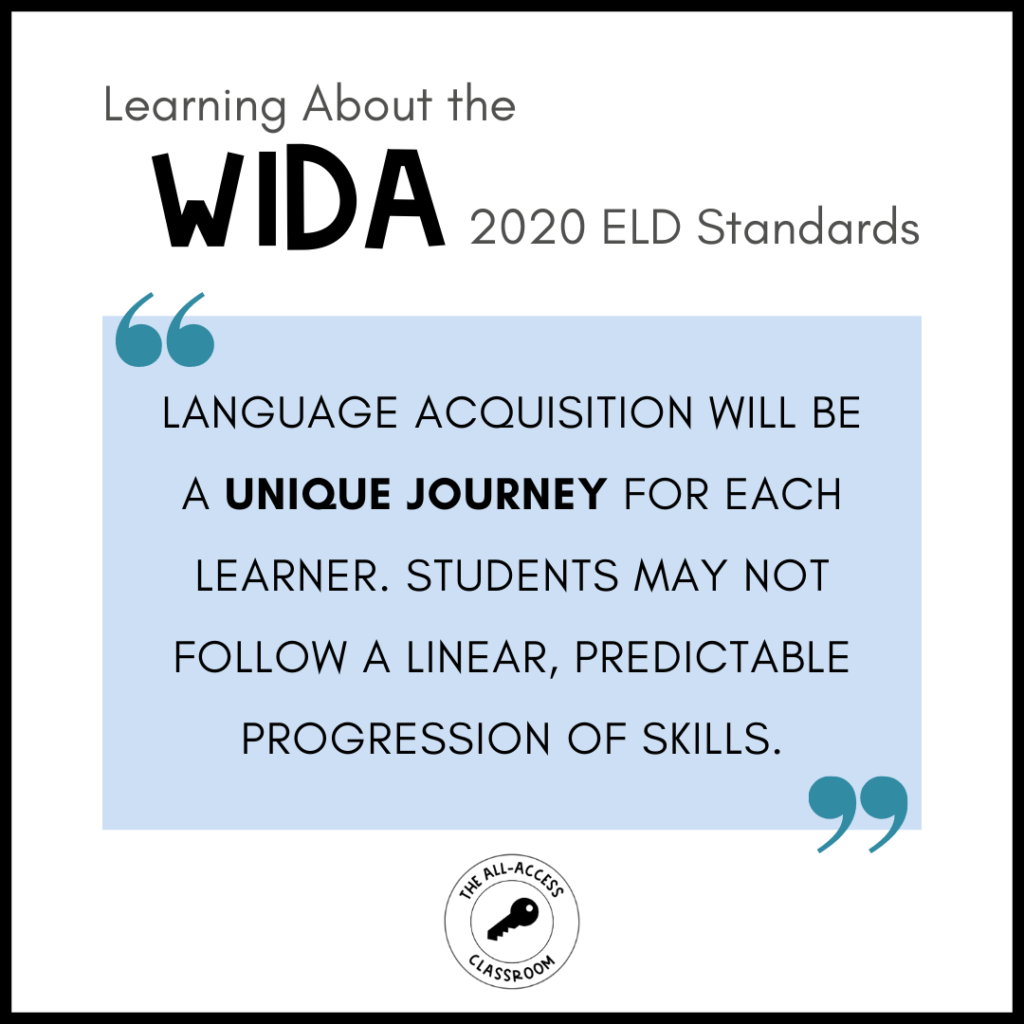
Ways to Use the Proficiency Level Descriptors (The New Cousin to the Can Do Descriptors for WIDA Standards Users)
So, how are we supposed to use these Proficiency Level Descriptors? Here are some suggestions:
- Similar to the Can Do Descriptors, they can give teachers a sense of what language to expect from students at various proficiency levels. They can help those who aren’t EL specialists gain a better understanding of language development.
- For those planning for instruction, they can guide decision-making about when and how to scaffold learning activities. Teachers can be more confident that students can meet the language demands of whatever activities before them. Students can be supported well, and challenged to practice new language skills.
- The PLDs can be helpful when teachers engage in collaborative discussions around planning or student growth. We can gather student work samples for portfolios. We may collect anecdotal notes and oral language recordings. When paired with the PLDs, these are some ways to assess where students are, and next steps.
- We can let the PLDs guide some language goal-setting for/with students, and monitor progress.
We always keep in mind that the PLDs are just one way of defining student language progress. It’s always desirable to bring multiple data points or assessments into discussions around student performance.
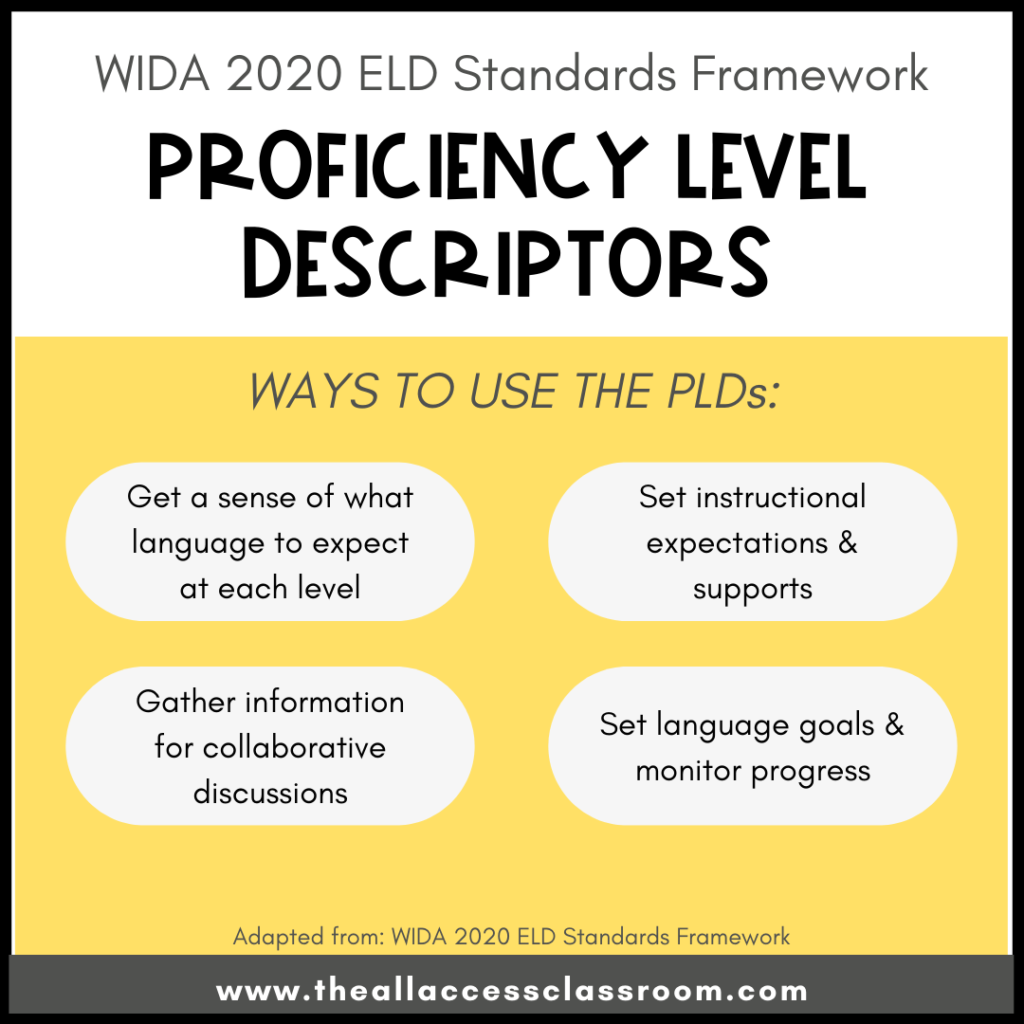
For more learning and support:
WIDA Standards Implementation Bundle
- Check out the other blogs in this series! Part 1 and Part 2
- Explore the online learning options available through WIDA
- Follow The All-Access Classroom on Instagram and Facebook for more tips and strategies for supporting multilingual learners!
- Join my email list to stay connected to content that is released
I hope this series was super helpful for you! I look forward to continuing to implement the WIDA 2020 Standards in my own practice. Let me know how it goes for you!


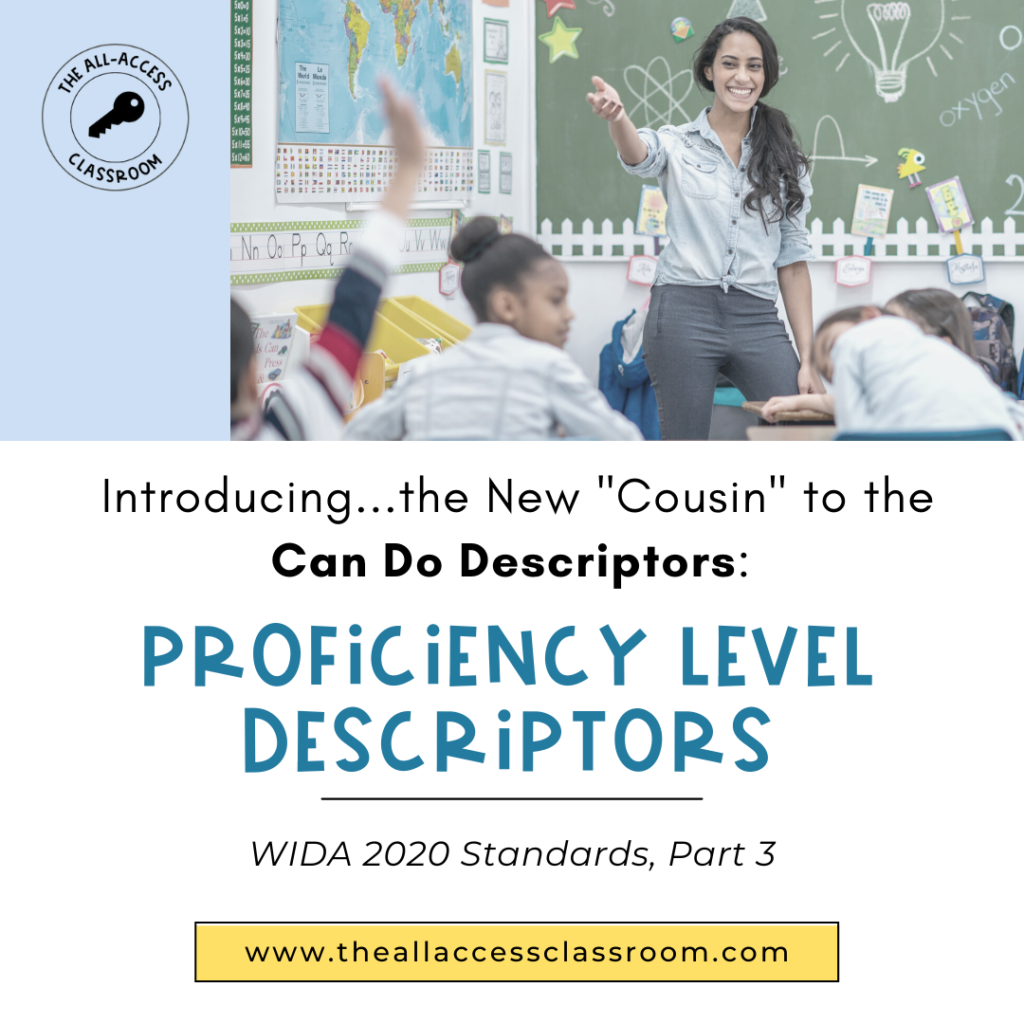
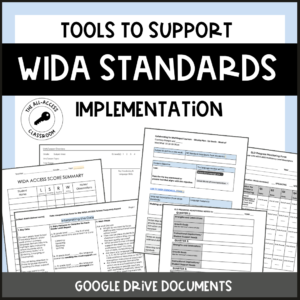

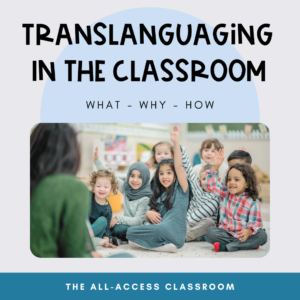


28 Responses
I am looking for your blog post (or did I see it on Instagram) about interpreting WIDA Access scores. I think you also had a template to fill in for students’ names and scores. Can you please point me in the right direction? I recently received the data and I would like guidance on what I should do next with it. Thank you for ALL your great resources! I heard about you from Beth Vaucher at Equipping ELLs.
Hi Jennifer! Thank you so much for checking out my content here! I’m happy to help you out! I think I know the template you’re referring to, and I can email you a copy if you’d like! I also have a district-level data reflection form I can share, if that’s something that would benefit you. Will you email me at courtney@theallaccessclassroom.com? Just say “Hey, it’s Jen who needs the template.” 🙂 Thanks again!
can I also receive this template? mjrendon1@gmail.com
Hi Martha! Absolutely! The security features on my email service keep me from emailing you directly without an initial contact from you…So would you just shoot me your request at courtney@theallaccessclassroom.com? Happy to help! Have a great day! 🙂
Can I also get the template? mwashington@washoeschools.net
Hi Monica! I’d love to help you out! Will you email me at courtney@theallaccessclassroom.com? That way I can be sure that my response to you doesn’t go to your spam! 🙂 Thanks! Courtney
I would love to have the template as well!
Hi Monique! Absolutely! If you’ll just email me at courtney@theallaccessclassroom.com, I’ll send it right to you! Thanks for checking out the blog!
Looking forward to receiving the template
Hi Jennifer!
I appreciate your blog. I have been using Can Do’s over the last couple of years to monitor my students’ growth and drive my EL instruction. This year my district made a big change to focus on PLDs. We now will be monitoring and creating language plans around PLDs but I don’t know a lot about them and am finding them harder to understand/implement. In my mind they are a mix between can do’s and the interpretive rubrics WIDA has created in the past. I don’t get them or like them {yet}. Any suggestions?
Courtney, I am so sorry! I was reading Jennifer’s post and accidentally typed her name when I was writing. oops!! My last comment was intended for you Courtney 🙂
It’s all good, no problem Chelsea! 🙂 I definitely hear you…the PLDs are very new and quite unique. I’ll email you a PD I did on the PLDs, and some other information.
Hi! Do you have any lesson planning templates that can be used with the new WIDA standards, language features/functions, and the PLDs?
Hi Suzanne! I have one with everything but the PLDs. I’m happy to share it with you if you’ll email me at courtney@theallaccessclassroom.com. Have a great day! 🙂
Hi Courtney,
My name is Daifa Cegueda. I am a bilingual pull out teacher. May I have the lesson planning template as well?
Thank you very much for your support.
Daifa Cegueda
Hi Daifa! Sure thing! If you would, please email me your request, at courtney@theallaccessclassroom.com. This will help keep my email back to you from being marked as spam. 🙂
Thanks, and have a great day!
I would love the same resources the others are requesting, such as the template and your PD about PLDs.
I just signed up today
Thank you,
Teri C
tcolgan@mpspk12.org
Hi Teri!
I’d love to help you out! Will you email me at courtney@theallaccessclassroom.com? That way I can be sure that my response to you doesn’t go to your spam! 🙂 Thanks! Courtney
Hello! I just sent you an email asking for resources that might highlight the text features of the WIDA standards. I hope it didn’t go to spam:)
I got it Katie! Thanks, and I’ll email you soon!
I would love the material too. Gracias!
Hi Lizdelia,
I’d love to help you out! Will you email me at courtney@theallaccessclassroom.com? That way I can be sure that my response to you doesn’t go to your spam! 🙂 Thanks! Courtney
Hi! This post is sooooo helpful! Thank you so much!! I’m looking for student friendly proficiency level descriptors (something that could be used with students for goal setting) OR examples of goals made by using the PLDs.
Hi Karina! Thanks for your patience! I’m so happy that the post on the PLDs was helpful! I love your request/ideas so much, and I’ve had it on my mind to create a kid-friendly version of the PLDs. I’m putting this on my “to-be-created” list! Thanks for being part of this community! 🙂 – Courtney
Hi! What do you use to determine a student’s expressive language level? I have several cases where students’ speaking and writing abilities are markedly different. Should I get the average using their WIDA speaking and writing scores? Or take a more individualized approach using multiple data points like anecdotal notes and sample work?
Hi Kayla,
Thanks for your patience! This is a great question! I would definitely aim to gather assessment data for the two expressive modalities of speaking and writing separately. I would gather speaking and writing samples based on prompts (Flip is a great tool to record speaking). Then I’d use the WIDA PLDs to serve as a frame for identifying where the student is in different features of expressive language. Other thoughts: Yes, absolutely use other informal and formative assessment measures over time (along with WIDA ACCESS scores), to curate a clear picture of student growth. Also, I would perhaps give students prompts (to gather expressive language) after a unit of instruction has been taught, so that the assessment can fairly assess the language capabilities of the student, without content knowledge/vocabulary as an obstacle. I would just be sure to be consistent in this over time, so that your progress monitoring can be as valid as possible. I hope this helps! – Courtney